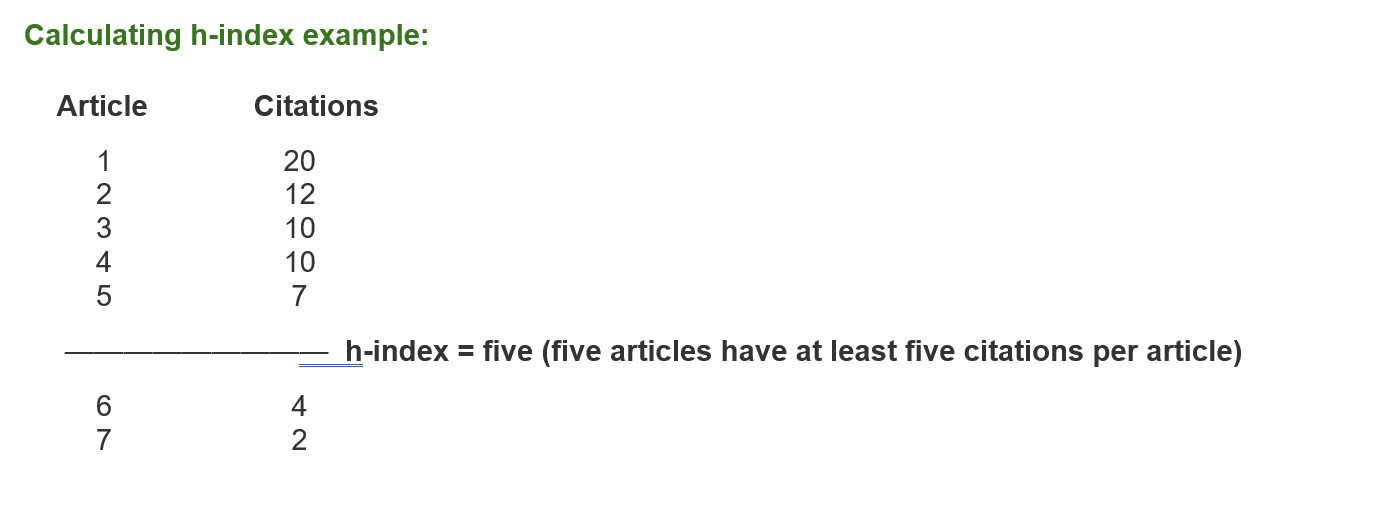The type of impact your work may have on the research community, economy, environment, and society varies. Impact also means different things across different disciplines and there is no standard way to demonstrate it. As graduate studies are primarily focused on research, let’s explore two established metrics that are commonly used to measure impact on the academic community (i.e. they tend to focus on citation count): the h-index and journal impact factor.
h-index
The h-index is the most widely used metric at the author level, measuring both productivity and citation impact of your scholarly output. While the h-index weighs heavily in the sciences and medicine, it is less important in the humanities, social sciences, economics, and law. Developed by Jorge E. Hirsch in 2005, the h-index is calculated by ranking your list of scholarly publications in descending order by how often each publication has been cited. For example, if you have an h-index of five, this means that on average, you published a minimum of five papers that have received a minimum of five citations each.
To optimize the h-index for early career researchers, benchmark yourself with researchers in the same field and with similar career length so that it is a fair comparison. The h-index is available in Google Scholar after you create a Google Scholar profile (see Figure 1) or in subscription-based databases such as Scopus and Web of Science. To create your own Google Scholar profile, click here for instructions.

Journal impact factor
In addition to the h-index, you may want to highlight where your articles are published, especially in journals with high impact factors. Similar to the h-index, not all disciplines value this metric. The journal impact factor (JIF) is a journal-level metric to quantify the “perceived quality” or importance of the journal. The JIF is calculated by dividing the total number of citations that the journal receives by the total number of scholarly items (i.e. articles, reviews, and proceedings papers) published in the journal in the previous two years. For example, if a journal has an impact factor of two, this means an item published in that journal would receive an average of two citations in the past two years.
As a newer researcher, you may use JIFs to help you make informed decisions on where to publish your research. Some publishers list the JIF directly on the journal’s website. But to verify the value, search for the journal title in Journal Citation Reports (a subscription resource within Web of Science). You may also use Journal Citation Reports to identify journals within your particular field and this could be a starting point to narrow down the journals that would make a good home for your work.
Despite the simplicity of assigning a value to quantify an author’s or a journal’s “research productivity,” there are a number of limitations with the h-index and JIF. They do not take into consideration the differences on how research is disseminated across different disciplines. While publishing scholarly articles may be the norm in engineering, science, and medicine, the social sciences publish books or book chapters. JIF’s calculation is also problematic as it uses a mean value for highly skewed data; outliers are included in the dataset. Since these long-standing metrics have been around for so long, they are preferred by the academy for good or ill. As a newer scholar, it is prudent to be aware of the established metrics and their limitations, as well as recognizing other ways of demonstrating your research impact.
Alternative metrics
What if you have not published any articles yet or have sparse publications? There are other ways to convey your research impact other than using the h-index or JIF. Since it takes time to accumulate citations, use alternative metrics such as the total number of views, downloads, and social media mentions that your articles receive. Or perhaps you were interviewed by the media to share your expertise.
Consider depositing conference presentations, video recordings, academic posters, or other scholarly output into an institutional repository to share your research globally. Most repositories also track views and downloads. For example, over a thousand views or downloads is significant and should be celebrated! Many academic institutions have an institutional repository, or digital archive, to collect, preserve, and share intellectual output produced by students, faculty members, and researchers. Leverage the internet in your favour, think creatively on how to disseminate your work – use Twitter, write blogs, make podcasts, or connect with the communications person in your department to write a feature story.
These are some ways to make your research more accessible to the world. When applying for grants or awards, also mention collaborative efforts with prolific researchers in your field or with international scholars. This highlights your potential for collaboration and your ability to work with established experts in your discipline.
Measuring research impact is not easy but libraries are here to help! Reach out to your librarian to inquire about common research metrics and how you may showcase your research story. The examples provided are but a few methods to share research findings. Have you tried other innovative or creative ways for disseminating your work? Tell us about them!


Journal ranking and impact are total nonsense. This system is just filling the pockets of the big publishers. Why can universities not make these articles free?